There is something slightly demoralising, as a band, when a stream of “support act” slots turns into a river, so that pretty much the only time you’re on a stage is before other musicians. And that coveted “headline” slot? It may as well be another gig on another planet. Of course, when you’re coming through the ranks, support act slots are gold: you’ll play with pretty much anyone, as long as there’s roughly a fit. And, let’s face it, often when there isn’t.
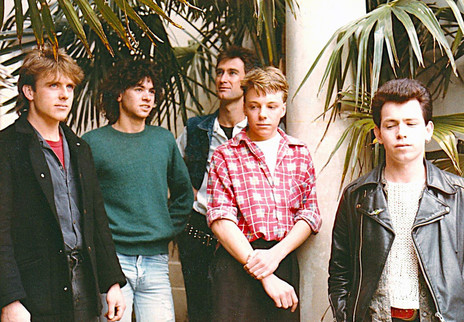
Grey Parade in the entrance of the Mayfair apartments, Parnell, June 1984. From left: John Callander (guitar), Grant Bedford (drums), Lee Cooper (bass), Michael Larsen (keyboards), and Paul "Eddie" Edmond (vocals). Photo by Manolo Echave.
You can’t hide in the practice room forever, and those first gigs – whether you’re a novice or a well-honed unit – are a critical part of the journey, helping you find your sound, finding how you fit together live, or finding your way to the bathroom after too much pre-gig nerve-containing ruby port.
I was in Grey Parade, an Auckland pop band, for about 18 months, mid-1984 to late 1986. We played a lot of support slots. Indeed, our first ever official gig was with Graham Brazier’s Legionnaires in autumn 1985, at The Gluepot. Not a bad support slot for a band barely out of the practice room.
As a second-year arts student, this was heady stuff, and I raced for the Auckland Star when the listing came out. We were billed as “Gary Parade”. The ignominy. It sounded like some folk-dude with flares and a beard, not a tight pop unit with a penchant for “borrowing” the eyeliner samples at Smith & Caughey of a Friday night, on the way to a gig or a club. Dear God. Maybe we should have seen that as a sign that we might forever remain, well, largely misrepresented, misunderstood and misaligned.
The two memories from that gig I hold clear to this day: Graham himself necking a third of a bottle of scotch in admirably short order, before he took to the stage; my being screamed at by one of their roadies after the show. Charged with coiling leads at the end of the night, I proved to be inadequate to the task: “What the fuck are you doing?!” Well, I wasn’t entirely sure. Surely, from there, the only way was up.
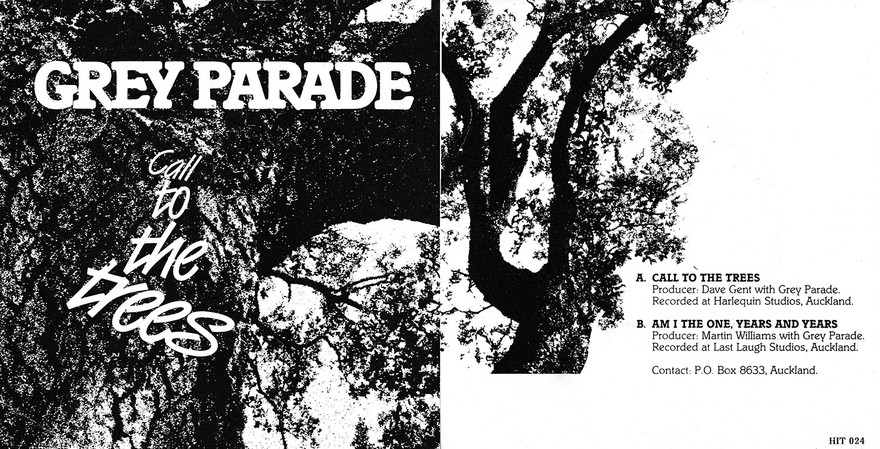
Grey Parade - Call To The Trees, both sides of the picture sleeve (Hit Singles, 1985). "Agreeably catchy, stylish and melodic without really being exciting," wrote Russell Brown in his Rip It Up review of the A-side.
The live scene in Auckland in the mid-80s had diminished to a handful of playable venues, only a couple of years from when it was healthy, vibrant, multi-faceted and offering punters and band alike an array of stages to worship at and grace [see Colin Hogg: The Tinnitus Years Part 5.] Sweetwaters finished up. Venues closed, and those that remained open found that live bands were more trouble and less revenue-generating than they were worth. The “kids” had hit the clubs, of which there was an explosion – Quays, Cause Celebre, the Brat/Bomb, Zanzibar. Club music was suddenly king. Live music, especially original live music? Hmm, not so much.
We had a handful of good gigs which our hard-working, cajoling manager Manolo Echave secured for us. We played at the Windsor Castle with Car Crash Set, where, as keyboard player, I was humbled by the generous Mr Bulog’s offer to use some of his set-up (kid, candy store), an unusually benevolent act for a headliner.
We played a strange gig upstairs in Victoria Street somewhere with You’re A Movie (a band with whom we could have an “Obscurity Knocks” competition, one suspects), and ahead of a band also grasping the greasy ladder to success, who were perhaps a rung above us, at a rather violent Mainstreet gig. The guitarist from said main act used his “axe” in a most literal sense to break up the mob, while we cowered in the tiny room behind the stage. A night to remember?
The paucity of good live venues and correspondingly arresting local bands was echoed by the international scene. Those mid-tier acts that seemed to descend regularly – I remember seeing in 1980 through 1981 Ultravox, the Cure, and New Order – stopped visiting almost completely.
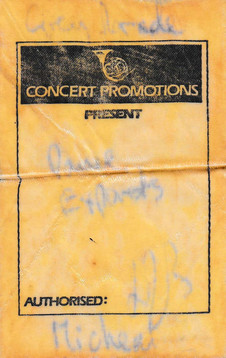
Michael Larsen's show access pass, Grey Parade supporting the Dance Exponents, 1985.
We were invited to join the Dance Exponents’ Expectations tour of winter, 1985. (Yes, well noted, a slightly hubristic title for a tour, that. But, you know, we released our only song on the Hit Singles label: it peaked for a week at No.49, I believe. You gotta be ambitious, right?) Through the band’s desire to “share the love” there were three support acts across the motu: You’re A Movie did the north of Auckland shows, we did Auckland to Wellington, and The Punch got the South Island slots. Sadly, the audiences were thin on the ground – a then-elevated ticket price ($15, from memory) combined with a sonic shift in direction from that famous first pop album meant that, mostly, the kids stayed away, while the potential rock audience considered the band not credible enough for them to attend.
Inspiring venues such as the town halls at both Auckland and Palmerston North were pretty vacant. But it was good grounding for us: our sound guy nearly rolled the van on the big hill near Palmy, and we got screamed at by young girls at New Plymouth Girls’ High School (we “headlined”, and I suspect they would have screamed at Mozart if he’d come to town with a five-piece). Mostly we supported, stoically.
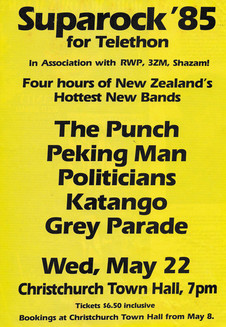
Grey Parade join Peking Man, Katango and others at Suparock '85, Christchurch Town Hall.
We did have our own gig, at the Hillcrest on the way home on that Dance Exponents tour, having played the Shazam! Christchurch show with various pop acts (Katango, Peking Man, The Punch). Notable non-performing event: our singer, Eddie Diehard getting busted by co-host Karyn Hay raiding the makeup in her dressing room. **Awkward**.
We drove straight through from the South Island, while I’d been dialling home from phone booths at every burger and toilet stop along the way in an attempt to motivate family members into some through-the-night video recording: it was 13 July 1985. Live Aid! (Rock rule #238: do not book a live gig on the night of a massive international rock charity event. Two men and a dog sat through our set, along with the other hapless band also unknowingly billed with us.)
We did manage to land a couple of international support slots, which sit at extreme ends of the pop continuum, it must be said. Continuing our dance with the cinematic theme, Moving Pictures came to town and played at the Ace of Clubs, just before it became the Six-Month Club. A strange choice of venue for an Aussie rock band. Of course they played ‘What About Me?’ More than once. To say their star had waned would be to misrepresent a waning star – the small venue was not exactly heaving. To give them their due, the Pictures played like it was Wembley – I do recall the diminutive singer, resplendent with pink guitar, peeling off the notes while he stood precariously on a table some 10 metres from the stage, much to the bewilderment of the punters seated around him. They moved their Coruba and Cokes gingerly to one side as his Cuban heels slid dangerously in the alcoholic detritus.
But then, we landed the support slot for Tears for Fears, August 10 and 11. Our manager and unsung hero Manolo had simply, smartly, sent our demo to their label when he heard they were touring – no one else had bothered, evidently, and we got the gig. The weekend we played with them (okay, for them) they had the No.1 album and single in the US. This was The Big Time. Even as a support.
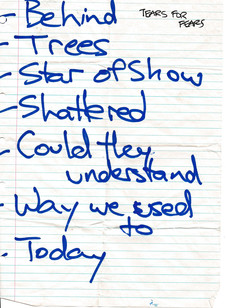
Grey Parade's set list for their Tears For Fears support slot, Logan Campbell Centre, August 1985.
And support we were. That was made very clear to us from the outset. Standing mid-afternoon in a screechingly echoey Logan Campbell Centre while the Tears went through a couple of global smashes, we were quickly moved on by one of their security chaps who informed us that “the band don’t like being watched in rehearsal”. Rightio.
We saw the Tears’ Curt Smith and Roland Orzabel only once, backstage in the tunnel, as they returned grumpy and empty-handed after trying to find a decent vegetarian restaurant in Auckland (it was 1985, chaps, did you try Gopals?). Their eyes were glued to the concrete walls as we shuffled past. We played our 20-minute set, the room was choking, there may have been polite applause. You knew, somehow, that this wasn’t going anywhere to building a fanbase. But you took what you could get.
Afterwards, we were delighted when, sinking into our small dressing room, that Manolo – resourceful again – came back from a strange mission with a tray of Steinlager cans. We made short work of those white bullets, after all that toil. He later discreetly revealed that in the true camaraderie that exists between musicians who ply the world’s stages in the name of their art, the beer had been generously … sold to him by the Tears organisation for, as I recall, $50.
Which seemed somehow to say a great deal. There we were, having played one of the biggest support gigs in the country that year, with a band that were printing money around the world, and we got to spend a goodly portion of our fee on a beer after the gig. All levels of wrong. But that’s rock and pop and roll, and you roll with the punches, right? As they say in the boardrooms of the nation: it is what it is.

Grey Parade on the Auckland waterfront, Quay Street, June 1984. From left: Lee Cooper, Michael Larsen, Grant Bedford, Paul Edmond, and John Callander. Photo by Manolo Echave.
We were a good enough band, a hotchpotch of ages and styles but well-grooved players, playing catchy enough pop songs, delivered with panache and zip. But, you know, so what?! A perfect storm of diminishing returns and that exodus to Clubland left bands like us flat-footed, club-footed even, limping along in search of a decent venue, a good crowd, a fee that wasn’t insulting, and hopefully a chance to move the dial on our “career” prospects. Not to be.
Do I regret any of it, wishing it were glitzier, more glamorous, the gigs better attended? Meh. I was 18. I got to plug in and play in places beyond my bedroom, beyond the practice room, beyond the borders of my home city. I ate terribly and sometimes played well. I met some amazing, crazy folk, slept on the floor of the legendary Punch flat in Christchurch, and in the spare room in the guitarist’s dad’s house in Johnsonville. I got to play with – and so watch and enjoy – probably 30 really good local bands, a couple of international ones and, in there, witness a few shockers as well.
Oh, and the other thing I realised, as I was finishing up after band practice the other night: I’m really, really good at winding leads.
--
Michael Larsen is the author of See Me Go (Auckland: Penguin, 2003) – conversations with, and road stories from, New Zealand musicians.